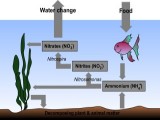Aquarium Filtration Explained

In the 'Water Chemistry' section we introduced you to the fundamentals of your aquarium's water chemistry.
Removing waste and toxins from the water is called filtration, and in this a companion section we take a closer look at how we keep the water clean.
The one thing that you must remember is that the biological make up of your tank is the most important aspect of filtration.
Main Filtration Types
Introduction
There are three main types of filtration mechanical, chemical and biological.These are normally used in conjunction with each other and without them your tank would soon become a soup of toxins killing all your fish.

Biological Filtration
Biological filtration relies on beneficial bacteria in the water to turn highly toxic ammonia into nitrite and then finally into less harmful nitrate.This is called the Nitrogen Cycle and is the most important of the three filtration systems mentioned.
Ammonia created by fish waste and organic materials decomposing is highly toxic. Bacteria first break this down into nitrite, which is also very dangerous for fish. Finally this is converted to nitrates, which are a lot less harmful.

Mechanical Filtration
Mechanical filtration removes waste particles floating in the water, you can think of this as similar to using a strainer or sieve in the kitchen.The classic example would be a pump that passed water through a sponge which collects the waste particles.
The medium in this example a sponge will also contain the bacteria that help to clean the water.

Chemical Filtration
Chemical filtration removes waste that has dissolved in the water and is invisible to the eye.This filtration system normally involves running the aquarium's water over activated carbon or zeolite.
Following on from the example above the filtration system along with the sponge and the bacteria would also have carbon.
This is then using all three systems in conjunction.
Other Filtration Types

Protein Skimmer
A protein skimmer is a form of mechanical filtration which is generally only used in marine aquariums. It differs from other mechanical filtration in a number of ways so we thought it best to give it its own category.- Unlike other mechanical filtration systems protein skimmers completely remove the waste to a cannister that is separate and not in contact with the aquarium's water.
- The function of a protein skimmer is to remove organic compounds before they begin to decompose and break down into nitrogen.

Plants
Plants in the aquarium will also act as a form of biological filter removing nitrates and other nutrients from the water.Adequate lighting and husbandry is needed and do not rely on them to remove all the nitrate present!

Water Changes
Whilst not really filtration in the true sense of the word frequent water changes will reduce organic matter and also nitrate levels.This used in conjunction with the filtration methods mentioned above will ensure that the water is in an ideal condition for your fish!